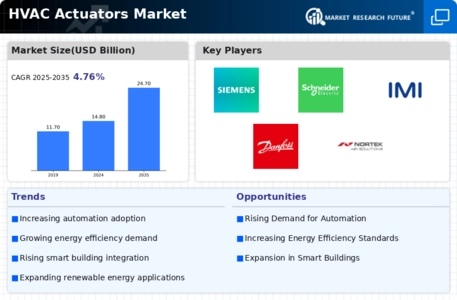Growth of Smart Buildings
The Global HVAC Actuators Market Industry is witnessing substantial growth due to the proliferation of smart buildings. These structures utilize advanced technologies to optimize energy use and enhance occupant comfort. HVAC actuators are integral to this ecosystem, facilitating precise control over heating, ventilation, and air conditioning systems. The increasing investment in smart infrastructure is projected to propel the market to a value of 24.7 USD Billion by 2035. Furthermore, the trend towards urbanization and the need for efficient building management systems further underscore the importance of HVAC actuators in modern construction.
Market Growth Projections
The Global HVAC Actuators Market Industry is poised for substantial growth in the coming years. Projections indicate that the market will expand from 14.8 USD Billion in 2024 to 24.7 USD Billion by 2035. This growth trajectory suggests a compound annual growth rate (CAGR) of 4.76% from 2025 to 2035. Factors contributing to this expansion include rising energy efficiency demands, technological advancements, and increased investments in smart building infrastructure. The market's evolution reflects broader trends in sustainability and automation, positioning HVAC actuators as critical components in modern HVAC systems.
Rising Demand for Energy Efficiency
The Global HVAC Actuators Market Industry experiences a notable surge in demand for energy-efficient solutions. As energy costs continue to rise, consumers and businesses alike are increasingly seeking technologies that optimize energy consumption. HVAC actuators play a crucial role in enhancing system efficiency by precisely controlling airflow and temperature. This trend is reflected in the projected market value of 14.8 USD Billion in 2024, indicating a robust growth trajectory. The emphasis on sustainability and reduced carbon footprints further propels this demand, as regulatory frameworks worldwide encourage the adoption of energy-efficient technologies.
Increased Focus on Indoor Air Quality
The Global HVAC Actuators Market Industry is increasingly driven by a heightened focus on indoor air quality (IAQ). As awareness of the health impacts of poor air quality grows, consumers and businesses are prioritizing HVAC systems that ensure optimal ventilation and filtration. HVAC actuators play a pivotal role in regulating airflow and maintaining desired IAQ levels. This trend is likely to contribute to a compound annual growth rate (CAGR) of 4.76% from 2025 to 2035, as investments in advanced HVAC technologies become more prevalent. The emphasis on health and well-being in indoor environments underscores the importance of effective HVAC solutions.
Technological Advancements in Automation
Technological advancements in automation significantly influence the Global HVAC Actuators Market Industry. The integration of smart technologies, such as IoT and AI, allows for enhanced control and monitoring of HVAC systems. These innovations enable real-time adjustments based on environmental conditions, improving overall system performance. As a result, the market is expected to grow to 24.7 USD Billion by 2035, driven by the increasing adoption of smart building technologies. The ability to remotely manage HVAC systems not only enhances comfort but also contributes to energy savings, aligning with global sustainability goals.
Regulatory Support for Sustainable Practices
Regulatory support for sustainable practices significantly impacts the Global HVAC Actuators Market Industry. Governments worldwide are implementing stringent regulations aimed at reducing energy consumption and greenhouse gas emissions. These policies encourage the adoption of energy-efficient HVAC systems, which rely heavily on advanced actuators for optimal performance. As a result, the market is projected to reach 14.8 USD Billion in 2024, reflecting the growing emphasis on compliance with environmental standards. The alignment of industry practices with governmental initiatives fosters a conducive environment for the growth of HVAC actuators.
















Leave a Comment